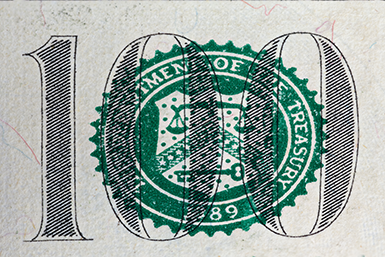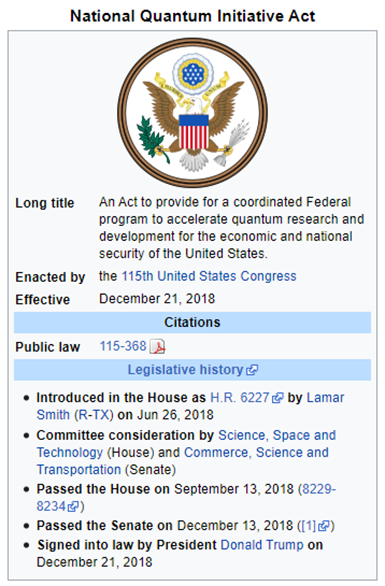| July 31, 2020 |
| Offshore Investment Guide |

Dear ,
Quantum leap is rarely used in scientific contexts, but it originated as a synonym of quantum jump, which describes an abrupt transition (as of an electron, an atom, or a molecule) from one discrete energy state to another. Quantum Interent will leap 5G and accelerate digital assets.
Gold will not be the standard because gold-laden astroids exist and will change the future gold supply. Ripple is both a digital currency (XRP) and an open payment network that was perfect for the USD.
By any reasonable definition, we already have a digital currency. It’s called the US dollar (USD). It’s managed by the Federal Reserve Bank. Almost 90% of US dollars have no physical existence – they are purely digital. But this isn’t just for the USA; world-wide, only 8% of currency exists as physical cash. Ripple replaces SWIFT system for USD.
|
| United States Paves the Way for Global Digital Asset Regulation |

Change is brewing in the world of digital assets—and most of it is encouraging. Recent news and developments this past year signal that the industry is maturing—with sophisticated financial institutions, central banks and global standard setting bodies all leaning into the discussion. This bodes well for smart and transparent digital asset regulation being adopted around the globe.
The real question is, which jurisdictions will lead this important change?
What Smart Regulation Looks Like
One example of an astute policy framework is the UK’s Financial Conduct Authority (FCA) digital asset “consultation.”
The FCA starts with a basic principle: regulation of blockchain and digital assets should protect the integrity of the market and consumers, on the one hand, while providing clarity to the industry, on the other. From there, the FCA sets a very clear taxonomy/classification ensuring that market participants understand which rules apply to which assets.
The FCA categorizes digital assets according to their primary use, such as utility tokens, exchange tokens or security tokens, but only security tokens that represent a stake in a business are subject to securities regulation. Under the UK framework, these securities laws don’t apply to the other tokens, despite the fact that some purchasers may buy those tokens purely for speculative purposes.
To lean into a bit of 90’s nostalgia, this would be akin to buying a Beanie Baby during their massive heyday, with the hope that they’ll eventually increase in value. That doesn’t make Beanie Babies a security, though. Beanie Babies are still Beanie Babies and exchange tokens are still exchange tokens.
The UK is not the only jurisdiction that is setting transparent regulation. Japan, Singapore, Switzerland and the UAE have also developed practical regulatory frameworks. Noticeably lagging behind, however, is the United States. This hurts not only the ability of American companies to compete, but also presents national economic and security concerns.
Why the U.S. Is Falling Behind on Digital Asset Regulation
In the U.S. the Securities and Exchange Commission (SEC) has seized control of digital asset oversight. The SEC initially took ownership because of the need to stop the abuses seen during the Initial Coin Offering (ICO) craze. But having successfully stopped these dangerous ICOs, which is positive for the maturity of the industry, the SEC is now stuck.
Essentially, the SEC has placed the regulation of digital assets into an old regulatory framework that governs items including orange groves, oil rigs, whiskey, pay telephones and even beavers—rules that simply aren’t fit for the applicable purpose of this emerging technology.
Contrast this with how the U.S. approached the regulation of the then new technology known as the internet in the 1990s. When it came to regulating the internet, the U.S., fortunately, took a much more flexible and forward-looking approach, rather than applying rules designed for rotary telephones or transistor radios.
That’s not to say the SEC hasn’t tried with building regulation of digital assets. Most notably, the SEC released a Digital Asset Framework (DAF) in 2019. However, this broad, expansive, non-binding framework lacks clarity and can essentially be interpreted many different ways by many different people—and guidance that can mean anything to anyone is no guidance at all.
Where U.S. Digital Asset Regulation Must Go from Here
As it did with the internet, the U.S. has the opportunity to lead the way on digital asset regulation and there are several paths to get there.
Congress can help by either passing sensible laws, or at the very least by holding regulators accountable. Another alternative is for the SEC and the Commodity Futures Trading Commision (CFTC) to join forces and develop a workable framework that protects the integrity of the markets and consumers without suffocating those U.S. companies seeking to innovate.
SEC Commissioner Hester Peirce’s safe harbor proposal is one example of what a sensible approach can look like. This safe harbor would provide a three-year window so that innovators, acting in good faith, can leverage this technology without being crushed by a myriad of intricate and technical securities laws as they start-up.
But whether it’s a legislative solution, a safe harbor like the one Commissioner Peirce is proposing or a collaborative effort between the SEC and the CFTC, what is clear is that we need a U.S. solution now. It’s bad enough if the U.S. were to cede a competitive edge to the likes of the UK, Japan or Singapore; it would be a disaster if the U.S. were to let Communist China take control of this technology. Unfortunately, that is exactly where the industry seems to be heading.
This critical point will be explored in the next part of this discussion. In the meantime, check out current policy frameworks from around the world.
|
| National Quantum Initiative Act |

President Trump signed a $1.2 billion law to boost US quantum tech on December 22, 2018
The new National Quantum Initiative Act will give America a national master plan for advancing quantum technologies.
The news: The US president just signed into law a bill that commits the government to providing $1.2 billion to fund activities promoting quantum information science over an initial five-year period. The new law, which was signed just as a partial US government shutdown began, will provide a significant boost to research, and to efforts to develop a future quantum workforce in the country.
The background: Quantum computers leverage exotic phenomena from quantum physics to produce exponential leaps in computing power. The hope is that these machines will ultimately be able to outstrip even the most powerful classical supercomputers. Those same quantum phenomena can also be tapped to create highly secure communications networks and other advances.
China, which has been investing heavily in quantum technology, sees the field as an opportunity to leapfrog the US. The European Union has also launched a €1 billion ($1.1 billion) quantum master plan. America has a long history of investing in quantum science, but it’s lacked a comprehensive strategy for coordinating research efforts. The new legislation, which has strong bipartisan support in Congress, should help fix that.
The details: The act establishes a National Quantum Coordination Office that will be part of the White House Office of Science and Technology Policy. It also calls for the development of a multi-year strategic plan to help keep America at the forefront of the quantum revolution.
One important aim of the plan will be to create new research centers that bring together academics from different disciplines, such as computer science, physics, and engineering, to help conduct experiments and train future quantum researchers. It will also encourage large companies and startups to pool some of their knowledge and resources in joint research efforts with government institutes.
|
| 10 key things to know about Ripple |

1. What is Ripple?
Ripple is the name for both a digital currency (XRP) and an open payment network within which that currency is transferred. It is a distributed, open-source payments system that’s still in beta. The goal of the ripple system, according to its website, is to enable people to break free of the “walled gardens” of financial networks – ie, credit cards, banks, PayPal and other institutions that restrict access with fees, charges for currency exchanges and processing delays.
2. What does Ripple do?
According to is OpenCoin, the company behind ripple, the currency addresses the need to keep money flowing freely. A company blog post titled “Ripple and the Purpose of Money” gives a brief history of money and its transportability, and points to the frustration of having banks and other institutions impede the transfer of funds with transaction fees and processing delays. The goal of Ripple, it says, is to build on the decentralized digital currency approach set by bitcoin and do “for money
what the internet did for all other forms of information.”
3. How would Ripple function like the internet?
Ripple’s chief cryptographer, David Schwartz, explains it like this:
“Payment systems today are where email was in the early ‘80s. Every provider built their own system for their customers and if people used different systems they couldn’t easily interact with each other. Ripple is designed to connect different payment systems together.”
Schwartz also anticipates the possibility of seeing “big companies lose their control over the flow of other people’s money just as they’ve lost control over the flow of information.”
4. Who’s behind Ripple?
The company building the Ripple protocol, OpenCoin, was co-founded by CEO Chris Larsen and CTO Jed McCaleb. McCaleb is well-grounded in digital currency, coming from Mt. Gox, which currently handles the majority of the world’s bitcoin trades. Larsen previously co-founded and led the online financial company E-LOAN. Other developers on Ripple’s team also have a bitcoin background.
OpenCoin recently picked up a round of funding from Andreessen Horowitz, FF Angel IV, Lightspeed Venture Partners, Vast Ventures and the Bitcoin Opportunity Fund.
(Note: OpenCoin is not to be confused with OpenCoin.org, which is developing an open-source version of an electronic cash system developed by David Chaum.)
5. Is Ripple like Bitcoin?
In many ways, yes. Like Bitcoin, Ripple’s XRP unit is a digital form of currency based on mathematical formulae and has a limited number of units that can ultimately be mined. Both forms of currency can be transferred from account to account (peer-to-peer, or P2P) without the need for any intervening third party. And both provide digital security to guard against the possibility of counterfeit coins.
6. Does that mean Ripple is a Bitcoin rival?
Ripple positions itself as a complement to, rather than a competitor with, Bitcoin. In fact, the site has a page dedicated to Ripple for bitcoiners.
The Ripple network is designed to allow the seamless transfer of any form of currency, whether dollars, euros, pounds, yen or bitcoins.
“Ripple will open up many more gateways for bitcoin users and easier ways to bridge bitcoin with the mainstream world of finance,” says Stephen Thomas, a senior developer for the ripple protocol and a bitcoin advocate.
7. How would Ripple benefit bitcoin users?
In addition to giving Bitcoin more ways to connect with those using other forms of currency, Ripple promises expedited transactions and increased stability. As a distributed network, Ripple does not depend on a single company to manage and secure the transaction database. Consequently, there is no waiting on block confirmations, and transaction confirmations can go through the network quickly.
Another advantage of using peer-to-peer is the absence of a “central target or point of failure in the system,” Ripple’s backers note.
8. How many Ripples will there be?
The company plans to ultimately create 100 billion ripples. Half of those are to be released for circulation, while the company plans to retain the other half.
9. Why is Ripple described as “free(ish)” rather than free?
Ripple doesn’t collect transaction fees the way PayPal, banks and credit cards do. However, it does take “a small portion of a ripple (equivalent to ~1/1000th of a cent)” from each transaction. That amount is destroyed rather than retained. The deduction is meant as to safeguard against the system being swamped by any one individual who might try to put through millions of transactions at once.
10. How much is a Ripple worth?
According to Bitcoin Charts, ripples were trading at around 115 per $1 (US) on May 17, 2013. (In early April, the price was about 1,000 per $1, so the currency has appreciated.)
|
| U.S. Government Says It’s Building A ‘Virtually Unhackable’ Quantum Internet |
|
The internet, that global interconnection of networks, routers and protocols flinging data around the planet, has touched almost every aspect of our lives. It is, arguably, the greatest invention of the 20th century. Unfortunately, it's also a flawed one. The existence of a $173 billion (£135 billion) cybersecurity industry highlights the scale of the data protection and privacy issues that consumers, business and governments face when using the internet.
But what if there was a 21st-century alternative that promised to secure the movement of data more completely than ever before?
What if there was a quantum internet that came with a promise of being virtually unhackable?
That's precisely what the U.S. Department of Energy (DOE) has said is to be built to usher in "a new era of communications" and push the U.S. to the "forefront of the global quantum race."
What's more, the DOE announced during a July 23 press conference, a working prototype is expected to be completed within the next ten years. I'll return to the unhackable claim shortly, but first, let's examine just what this quantum internet blueprint involves.
A strategic blueprint for the development of a quantum internet
The DOE press conference was held at the University of Chicago and revealed the details of a meeting between DOE national laboratories, universities, and businesses in February, where the plan to build a quantum internet was hammered out.
Emerging from the National Quantum Initiative Act that President Trump signed in December 2018, the participants prepared the strategic ground for a national internet built around the principles of quantum mechanics.
See this MIT Technology Review explainer of quantum communications for a brilliantly accessible overview of the technicalities.
Already in the early stages of development, the DOE hopes that the quantum internet will have a "profound impact on areas critical to science, industry, and national security."
As such, it is not intended as a direct replacement for the internet as we know it. Instead, it would run in parallel as a supplementary network for the banking and health industries as well as serving the national security interest.
The full report blueprint, "From Long-distance Entanglement to Building a Nationwide Quantum Internet," covers all the critical objectives from building and integrating quantum network devices through to expanding the network between cities and ultimately states.
Scientists from the DOE Argonne National Laboratory in Lemont, Illinois, along with those from the University of Chicago, have already created a 52-mile "quantum loop" in the Chicago suburbs. The next step will be to add the DOE Fermilab in Batavia, Illinois to establish an 80-mile testbed.
All 17 DOE National Laboratories will eventually be connected to form the quantum internet backbone, with this working prototype expected to be up and running within a decade. "The Department of Energy is proud to play an instrumental role in the development of the national quantum internet," the U.S. Secretary of Energy, Dan Brouillette, said.
However, as the Washington Post reported, the United States is far from alone in developing quantum networks, with China being the most significant rival. A 1,263-mile quantum link exists between Beijing and Shanghai, dwarfing the U.S. efforts so far.
Nothing, not even a so-called quantum internet, is unhackable
Paul Dabbar, U.S. Under Secretary for Science, said that the quantum internet brings the country "one step closer to a completely secure internet." As someone who has been involved in the business of online security for three decades, starting around the same time that the term cybersecurity was coined in 1989, Dabbar's last three words make me shudder.
There is no such thing as completely secure. A brand new and unboxed computer might have had malware installed somewhere along the supply chain, and the operating system will likely have vulnerabilities. Until you open the box, it is effectively Schrodinger's computer: secure and insecure simultaneously.
The DOE statement is somewhat more sensible, in my opinion when it talks of relying upon the laws of quantum mechanics to "control and transmit information more securely than ever before." More securely, not completely securely.
Then it goes and spoils everything by using the phrase "virtually unhackable networks."
A quantum internet will not be unhackable: it will likely be much harder for anyone to eavesdrop on the transmission of encrypted data using quantum key distribution (QKD), but that's not to say it's impossible.
Yes, the decryption keys are sent using qubits in a quantum state, which means that if a hacker were to attempt to observe them in transit, then they are altered, they collapse, the hack attempt is visible and the keys are discarded, new ones generated and the process starts again.
Great, in theory. In practice, and there are plenty of QKD networks operating already, it's the weak spots such as optical fiber termination points, switches and connections that will be targeted by hackers. Not forgetting the human element, be that by way of configuration errors, bad actors or social engineering attacks.
Security does not involve one single point of attack, quantum or otherwise.
By Davey Winder for Forbes
|
|
|





 About us
About us